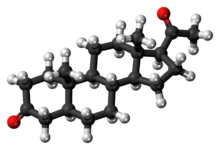5α-Dihydroprogesterone
 | |
 | |
| Names | |
|---|---|
| IUPAC name
(5S,8R,9S,10S,13S,14S,17S)-17-acetyl-10,13-dimethyl-1,2,4,5,6,7,8,9,11,12,14,15,16,17-tetradecahydrocyclopenta[a]phenanthren-3-one | |
| Other names
Allopregnanedione; 5α-Pregnan-3,20-dione | |
| Identifiers | |
3D model (JSmol) |
|
| ChEBI | |
| ChemSpider | |
| ECHA InfoCard | 100.008.453 |
PubChem CID |
|
| |
| |
| Properties | |
| C21H32O2 | |
| Molar mass | 316.48 g/mol |
Except where otherwise noted, data are given for materials in their standard state (at 25 °C [77 °F], 100 kPa). | |
| Infobox references | |
5α-Dihydroprogesterone (5α-DHP), also known as allopregnanedione,[1] as well as 5α-pregnane-3,20-dione, is an endogenous progestogen and neurosteroid that is synthesized from progesterone.[2][3] It is also an intermediate in the synthesis of allopregnanolone and isopregnanolone from progesterone. 5α-DHP is an agonist of the progesterone receptor and a positive allosteric modulator of the GABAA receptor (albeit with an affinity for this receptor that is regarded as relatively low (in comparison to 3α-hydroxylated progesterone metabolites such as allopregnanolone and pregnanolone)).[2][3][4][5] It has also been found to act as a negative allosteric modulator of the GABAA-rho receptor.[6] The steroid has been found to possess 82% of the affinity of progesterone for the progesterone receptor in rhesus monkey uterus.[7] 5α-Dihydroprogesterone has been said to possess about 33% of the relative progestogenic potency of progesterone.[8] In addition, it is a weak agonist of the pregnane X receptor (PXR) (EC50 >10,000 µM), with approximately six-fold lower potency relative to its 5β-isomer, 5β-dihydroprogesterone.[9]
Chemistry
See also
References
- ↑ Finn, Deborah A.; Purdy, Robert H. (2007). "Neuroactive Steroids in Anxiety and Stress". Handbook of Contemporary Neuropharmacology. doi:10.1002/9780470101001.hcn026.
- 1 2 Mellon SH (October 2007). "Neurosteroid regulation of central nervous system development". Pharmacol. Ther. 116 (1): 107–24. doi:10.1016/j.pharmthera.2007.04.011. PMC 2386997. PMID 17651807.
- 1 2 Guidotti A, Dong E, Matsumoto K, Pinna G, Rasmusson AM, Costa E (November 2001). "The socially-isolated mouse: a model to study the putative role of allopregnanolone and 5alpha-dihydroprogesterone in psychiatric disorders". Brain Res. Brain Res. Rev. 37 (1–3): 110–5. doi:10.1016/s0165-0173(01)00129-1. PMID 11744079.
- ↑ Rupprecht R, Reul JM, Trapp T, et al. (September 1993). "Progesterone receptor-mediated effects of neuroactive steroids". Neuron. 11 (3): 523–30. doi:10.1016/0896-6273(93)90156-l. PMID 8398145.
- ↑ Ocvirk, Rok; Pearson Murphy, Beverley E.; Franklin, Keith B.J.; Abbott, Frances V. (2008). "Antinociceptive profile of ring A-reduced progesterone metabolites in the formalin test". Pain. 138 (2): 402–409. doi:10.1016/j.pain.2008.01.019. ISSN 0304-3959. PMID 18343034.
- ↑ Johnston GA (2002). "Medicinal chemistry and molecular pharmacology of GABA(C) receptors" (PDF). Curr Top Med Chem. 2 (8): 903–13. doi:10.2174/1568026023393453. PMID 12171579.
- ↑ Illingworth DV, Elsner C, De Groot K, Flickinger GL, Mikhail G (February 1977). "A specific progesterone receptor of myometrial cytosol from the rhesus monkey". J. Steroid Biochem. 8 (2): 157–60. PMID 405534.
- ↑ Rogerio A. Lobo; Jennifer Kelsey; Robert Marcus (22 May 2000). Menopause: Biology and Pathobiology. Academic Press. pp. 433–. ISBN 978-0-08-053620-0.
- ↑ Lehmann JM, McKee DD, Watson MA, Willson TM, Moore JT, Kliewer SA (1998). "The human orphan nuclear receptor PXR is activated by compounds that regulate CYP3A4 gene expression and cause drug interactions". J. Clin. Invest. 102 (5): 1016–23. doi:10.1172/JCI3703. PMC 508967. PMID 9727070.